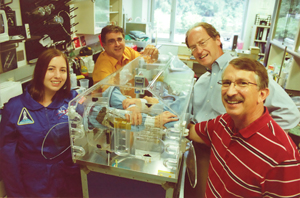August 27, 2012
 PITTSBURGH—Move over "Bones" McCoy. Future voyages of the starship Enterprise just might include astro surgery as this dynamic discipline jumps from the pages of fiction to reality.
PITTSBURGH—Move over "Bones" McCoy. Future voyages of the starship Enterprise just might include astro surgery as this dynamic discipline jumps from the pages of fiction to reality.
A team of biomedical engineering researchers from Carnegie Mellon University and the University of Louisville are developing surgical tools that could be used for future expeditionary spaceflights to the moon, an asteroid or Mars.
"In deep space, surgical procedures will be severely complicated by absence of gravity, where it becomes difficult to prevent cabin contamination from blood and body fluids," said James Antaki, a professor of biomedical engineering at CMU.
To address these challenges of surgical care in zero gravity, Antaki along with George M. Pantalos, a professor of surgery and bioengineering at the University of Louisville, and CMU researchers James E. Burgess and Jennifer A. Hayden are developing a watertight surgery system to isolate the wound and control bleeding by creating a pressurized aqueous environment within the surgical field.
"We have developed a dome-shaped structure [Aqueous Immersion Surgical System (AISS)] that can be mounted over the surgical area and will prevent contamination of the spacecraft cabin during surgeries that could include working on broken limbs or traumatic injuries," said Hayden, a Ph.D. biomedical engineering student from South Brunswick, N.J. The AISS is also designed to reduce or stop bleeding.
The system could potentially be used for a wide variety of ground-based surgery. In the U.S. alone, the number of patients undergoing major surgical procedures is estimated at 32.7 million annually.
Prototypes of the astro-surgical system will be tested on four separate flights of NASA's zero-gravity C-9 aircraft from Oct. 2-5 at Johnson Space Center Reduced Gravity Program at Ellington Field, southeast of Houston.
"Flights typically include four sets of 10 parabolic maneuvers. The flight profile determines the level of reduced gravity achieved by simulating the levels of gravity in orbit and interplanetary spaceflight, on the surfaces of the moon and Mars," said Pantalos, who has conducted 27 zero-gravity flight missions for NASA since 1992. The duration of each period of reduced gravity is between 23 and 30 seconds.
###
From left, Jennifer Hayden, a Ph.D CMU biomedical engineering student; CMU professors James Antaki and James E. Burgess along with George M. Pantalos of the University of Louisville showcase new biomedical engineering tool.
Press Release: Carnegie Mellon University Biomedical Engineers Lead Collaborative Team Developing New Astro Surgery Tools for NASA Deep Space Missions
Researchers To Test System Oct. 2-5 on C-9 Simulating Zero Gravity Conditions
Contact: Chriss Swaney / 412-268-5776 / swaney@andrew.cmu.edu PITTSBURGH—Move over "Bones" McCoy. Future voyages of the starship Enterprise just might include astro surgery as this dynamic discipline jumps from the pages of fiction to reality.
PITTSBURGH—Move over "Bones" McCoy. Future voyages of the starship Enterprise just might include astro surgery as this dynamic discipline jumps from the pages of fiction to reality.A team of biomedical engineering researchers from Carnegie Mellon University and the University of Louisville are developing surgical tools that could be used for future expeditionary spaceflights to the moon, an asteroid or Mars.
"In deep space, surgical procedures will be severely complicated by absence of gravity, where it becomes difficult to prevent cabin contamination from blood and body fluids," said James Antaki, a professor of biomedical engineering at CMU.
To address these challenges of surgical care in zero gravity, Antaki along with George M. Pantalos, a professor of surgery and bioengineering at the University of Louisville, and CMU researchers James E. Burgess and Jennifer A. Hayden are developing a watertight surgery system to isolate the wound and control bleeding by creating a pressurized aqueous environment within the surgical field.
"We have developed a dome-shaped structure [Aqueous Immersion Surgical System (AISS)] that can be mounted over the surgical area and will prevent contamination of the spacecraft cabin during surgeries that could include working on broken limbs or traumatic injuries," said Hayden, a Ph.D. biomedical engineering student from South Brunswick, N.J. The AISS is also designed to reduce or stop bleeding.
The system could potentially be used for a wide variety of ground-based surgery. In the U.S. alone, the number of patients undergoing major surgical procedures is estimated at 32.7 million annually.
Prototypes of the astro-surgical system will be tested on four separate flights of NASA's zero-gravity C-9 aircraft from Oct. 2-5 at Johnson Space Center Reduced Gravity Program at Ellington Field, southeast of Houston.
"Flights typically include four sets of 10 parabolic maneuvers. The flight profile determines the level of reduced gravity achieved by simulating the levels of gravity in orbit and interplanetary spaceflight, on the surfaces of the moon and Mars," said Pantalos, who has conducted 27 zero-gravity flight missions for NASA since 1992. The duration of each period of reduced gravity is between 23 and 30 seconds.
###
From left, Jennifer Hayden, a Ph.D CMU biomedical engineering student; CMU professors James Antaki and James E. Burgess along with George M. Pantalos of the University of Louisville showcase new biomedical engineering tool.